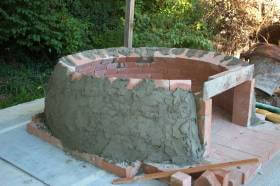Overview of the Brick Oven Assembly, Refractory Mortar
A Forno Bravo modular oven or a DIY brick Pompeii Oven should be assembled with a high-heat mortar. You have two basic choices: using the refractory mortar blend with Calcium Aluminate from Forno Bravo, which is included with your Forno Bravo modular oven kit (or can be purchased separately through the online store for DIY builds,) or using a mortar that you mix at the building site, using locally sourced materials. The site-mixed mortar can be made with standard Portland cement, or with refractory cement that includes Calcium Aluminate.
Forno Bravo’s Pre-Mixed Refractory Mortar
The best solution is to use a pre-mixed refractory mortar. Forno Bravo sells its mortar in 50 lbs. bags (dry weight.) You are guaranteed to have the right proportions of ingredients without having to source them independently, though you will still need to carefully add water and prepare and use the mortar in small batches, due to its chemical characteristics. This mortar is heat resistant to 1,700°F and is noted for its longevity. It’s made specifically for pizza ovens and fireplaces and is the same material that we use at the factory for our fully assembled ovens.
DIY Heat-Resistant Mortar
If you don’t want to worry about shipping our high-temperature mortar, or want to save money, you can make your own mortar, using either fireclay and Portland cement or fireclay and Calcium Aluminate. Fireclay is a heat resistant mortar made up of aluminate and silica. When you mix fireclay with Portland cement, sand, and lime, you create a product that is more heat resistant than basic mason’s mortar (Portland cement with sand and lime).
Measure your ingredients by volume (use a bucket or shovel to measure), and mix only the amount you will use within an hour or so.
- 1 part Portland cement
- 3 parts sand
- 1 part lime
- 1 part fireclay
DIY Calcium Aluminate Mortar
Still, fireclay mortar is less heat resilient and thermally conductive than a true refractory mortar. If you are building a commercial oven, or simply want to “go the extra yard,” but do not want to purchase Forno Bravo’s Calcium Aluminate mortar, you can make your own calcium aluminate refractory mortar on site.
First, a word of caution. Working with calcium aluminate can be challenging. If you get the mix or water wrong, it won’t set correctly. It partially sets very quickly, and you cannot re-hydrate it, so you have to mix it and use it in small batches. If you are working on a hot day, you may want to use chilled water with the mix to help stretch your working time a bit. Still, if you are trying to save money, and want or need the heat resilience, heat conductivity, and longevity of a true aluminate mortar, this formula will work.
- 1 part Calcium Aluminate
- 3 parts sand
- 1 part lime
- 1 part fireclay





